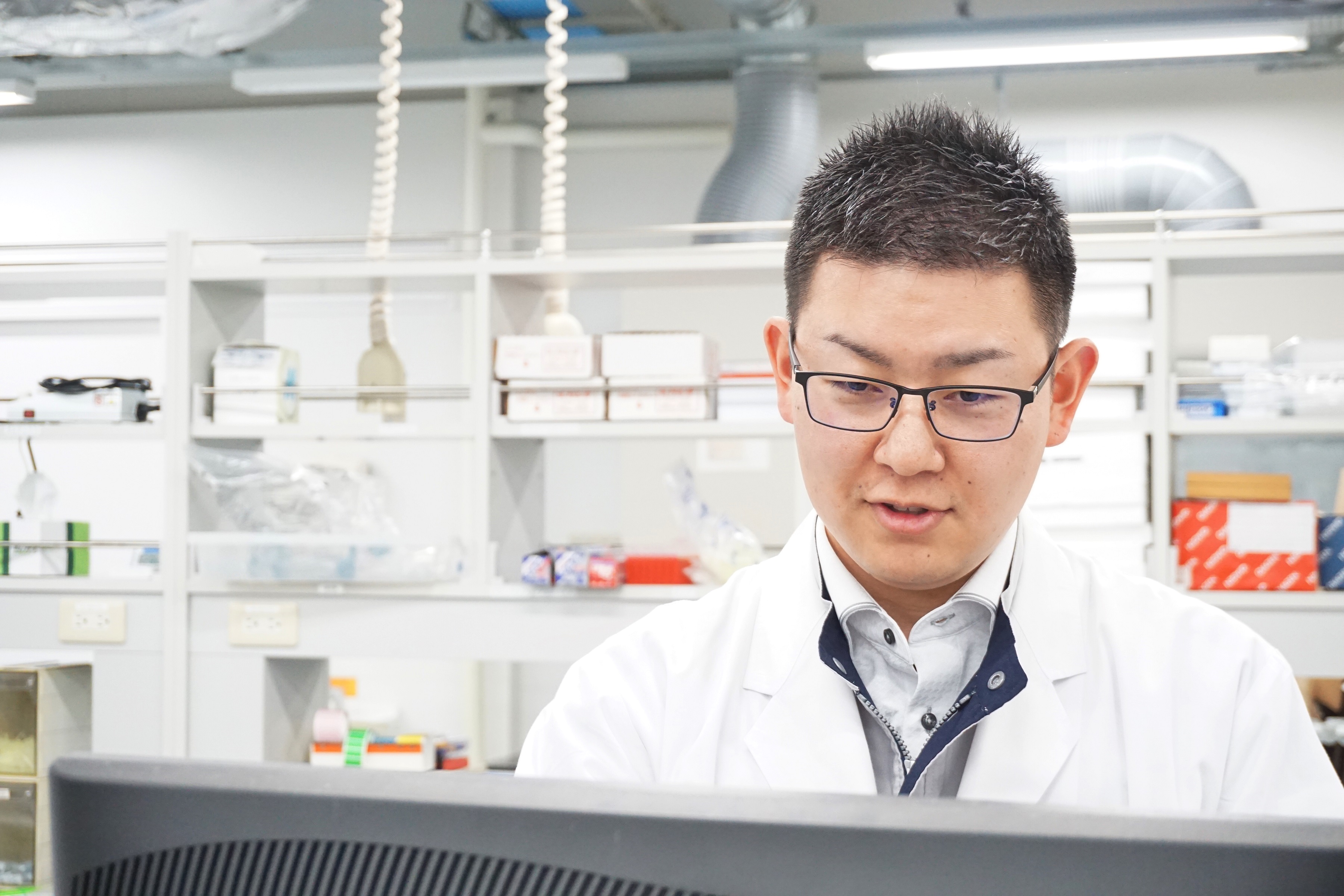EMPLOYEE INTERVIEW

Creating the future of healthcare with data analysis
and software development
Summary
- Collaborating with various engineers leads to growth
- True sense of making contributions to healthcare as a software engineer
- Sense of achievement when developing algorithms
Current Responsibilities
I am involved in software development for hematology testing instruments (blood cell counts analyzer). Although there are a wide range of tasks in software development, I am mainly involved in resolving issues through data analysis and integrating the results into our products. Specifically, I work with data on a daily basis to develop logic model that can distinguish between normal and abnormal samples. I’ve been doing this kind of work since I joined the company, but as the years go by, more and more tasks and responsibilities are being left to my discretion. I’ve now taken a leadership role, which means I’m responsible for team management, defining requirements, and design-related tasks.
Sysmex Career
-
July (1st year) ~ March (4th year)
Hematology Product Engineering Div. Product Development Dept. Involved in software development of hematology products. Gained experience in enhancing the quality and performance of existing products and adding new functions in accordance with market demands.
-
April (5th year) ~ the present
Second Engineering Div. Software Engineering Group In addition to the above, I have been conducting research into next-generation blood testing devices in collaboration with universities.
Q&A
Q. Why did you choose Sysmex?
I wanted to establish a long career in the healthcare industry, which is a growing market and contributes so much to society. When many people hear the word “healthcare”, they think that only doctors and medical professionals can save patients. I was one of those people. I first heard about Sysmex when I was a student and had an opportunity to attend a lecture by an alumnus. I remember being shocked to learn that testing plays a major role in healthcare. It was then that I decided I wanted to work for Sysmex, so I went to graduate school and chose to work in a medical laboratory. There were many other companies where I could use my major in information science, but Sysmex was the only one that offered an environment where I could continue to work for a long time, and not just in the short term. At Sysmex, I truly feel that I am growing through my collaborations with a variety of engineers, and the medical data I am working on is a treasure trove for the future of medicine, so I feel that I am contributing to medicine through my own field of expertise.
Q. Could you tell me more about the work you are currently involved in?
 I’m mainly engaged in three different tasks. The first task is the development of software for large hematology instruments, for which I analyze data to improve performance and quality after the product has been launched. The data analysis I carry out distinguishes whether a sample is normal or abnormal based on test data. This is known as a screening test and is the most commonly used test in medical examinations (if any abnormalities are found, a more detailed test is carried out). At present, we are focused on developing tests that distinguish between normal and abnormal, but in the future our goal is to provide added value by describing what the abnormality is. The second task involves the development of compact devices, which is very similar to the work I mentioned above. The third task involves conducting joint research with a university. At the university, I established a course called “Next Generation Blood Testing” and have been carrying out research as a research support member. Since I joined the company, I have been giving my opinions on next-generation blood testing, which led my boss to ask me if I would like to be a member of this particular joint research team. I think it’s important to proactively speak up and take on challenges.
I’m mainly engaged in three different tasks. The first task is the development of software for large hematology instruments, for which I analyze data to improve performance and quality after the product has been launched. The data analysis I carry out distinguishes whether a sample is normal or abnormal based on test data. This is known as a screening test and is the most commonly used test in medical examinations (if any abnormalities are found, a more detailed test is carried out). At present, we are focused on developing tests that distinguish between normal and abnormal, but in the future our goal is to provide added value by describing what the abnormality is. The second task involves the development of compact devices, which is very similar to the work I mentioned above. The third task involves conducting joint research with a university. At the university, I established a course called “Next Generation Blood Testing” and have been carrying out research as a research support member. Since I joined the company, I have been giving my opinions on next-generation blood testing, which led my boss to ask me if I would like to be a member of this particular joint research team. I think it’s important to proactively speak up and take on challenges.
Q. Could you tell me about an experience that has left a lasting impression on you?
It was when I was developing an algorithm to classify two populations. The challenge given to us by the customer was to classify two groups of white blood cells that were seen during hematology (blood cell counting) test. It is relatively easy for a professional laboratory technician to look at the cells and classify them based on their blood cell morphology. However, when blood and reagents reacted inside the device, and blood cells were converted into electrical signals by laser irradiation, they were sometimes judged to be of the same cell group, so they could not be distinguished properly. It was therefore not possible to provide test results that accurately indicated the patient’s condition. In order to solve this problem, we worked to develop an algorithm. There are various patterns in the way the two populations overlap, and we started by steadily organizing information, such as classifying Pattern A in this way and classifying Pattern B in that way. Blood cells have connective properties and when changed into electrical signals, the population becomes connected, which is a form that is extremely difficult for clustering. I dealt with various data every day and engaged in a lot of trial and error. After three weeks of hard work, I was able to develop an algorithm to separate the two groups. I was very happy that I was able to not only get a positive evaluation from my boss, but also provide a good result that satisfied our customer. It was a slow, repetitive task that required a lot of perseverance, but when I was able to develop the algorithm, the sense of accomplishment was huge. If I were to give you a simple example, it would be similar to the pleasure of working hard to solve a difficult math problem. By the way, I am the type of person who wants to solve difficult problems without fail and without giving up (laugh).
Q. Could you share a message with students looking for a job?
It is important to choose an environment and job type that matches your sense of values. You will spend more than half of your life working, so if you can do something that you find interesting, you are certain to enjoy your life – inside and outside the company!
Daily schedule
| 9:30 | [Commence work followed by information sharing and individual meetings]
Go to the office on a flextime schedule. Review progress and tasks in small teams. If there are any problems or unexpected tasks, discuss them with my superior and consider priorities and deadlines. |
|---|---|
| 10:00 | [Work]
Perform assigned tasks. Do personal work such as data analysis and data creation. |
| 12:00 | [Lunch]
Lunch at the company’s cafeteria |
| 13:00 | [Development Team MTG]
Confirm progress and development specifications with members of company partners. |
| 14:00 | [Project MTG]
Discuss specifications and plans for the entire project. |
| 15:00 | [Work]
Perform assigned tasks. Do personal work such as data analysis and data creation. |
| 19:30 | [Club Activities]
Enjoy playing basketball in the company gym with colleagues from different departments. |

